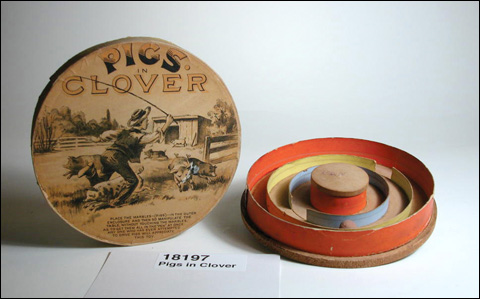By Christina Rubin

Charles Martin Crandall, born May 30, 1833, started inventing toys at the tender age of 12, and took over the Crandall Toy Company at age 16 upon his father’s death in 1849. The company under the guidance and ingenuity of Charles, became famous for its toy blocks, Crandall’s Acrobats, and numerous other well-known games and toys made of wood.
In January 1889, Crandall invented and brought to market a new toy which took the country by storm. It rapidly became the most popular toy nationwide and was being played everywhereÑon street corners, trolley cars, drawing rooms, pool halls, and even in the halls of Congress. Cleverly named “Pigs in Clover” the game required a skillful manipulation of marbles–“the pigs”–to be rotated around a series of concentric circles in order to corral all the pigs in the center –“the pen.”
The game’s success created many imitators, with many of them succeeding in cashing in on the toys popularity. Industrialist Moses Lyman, a financial backer of Crandall’s business ventures, actively pursued them all by bringing them to court for patent and trademark infringement. A major obstacle in this pursuit was the slowness of the patent office approval and Crandall’s own delay in filing the patent (the patent was filed in February 1889 one month after the toy’s release). Despite the many imitators, however, there seemed to be little affect on the output of the “Pigs” game. More than one million of the games were sold by late April 1889 as reported by Lyman. The patent was finally awarded in September of that same year, about the time the toys popularity began to decline.
The toy was also a great source of amusement to the press creating opportunity to attack the White House. In one widely circulated story that was picked up by several newspapers, the New York Tribune ran an article claiming that Senator William Everts from NY, purchased a toy, took it home where he sequestered himself in his library to play “at the gameÒ for several hours. He took the toy to the senate chambers the following day where he was met by Missiouri Senator George Graham Vest, who took it to the cloakroom. There, Everts and Vest were joined by four other senators, James L. Pugh (AL), James B. Eustis (LA), Edward C. Walthall (MI), and John E. Kenna (WV). A senate page was sent to purchase five more toys and the six senators held a “pig-driving contest.” About 30 minutes later, Senator Vest announced his accomplishment of driving in first, “the last pig in the pen.” This report was followed a few days later with a political cartoon in the New York World, dated March 17, 1889. The caption read: “Will Mr. Harrison be able to get all these hungry pigs in the pen?” It illustrated a man in shirtsleeves, President Benjamin Harrison(?) with the pig pen in the center of the gameboard representing the White House. The marbles in the cartoon were illustrated with well known politicians of the day. Harrison was also accused of playing with the game behind closed doors instead of “attending to politics.”
Although “Pigs in Clover” was produced in tremendous quantities they are hard to find today because of the fragility of the toy. Made of wood, printed paper and cardboard, and with a glass covering the top, the materials did not hold up well to constant playing. The toy seen here has survived in remarkably good condition and is in the collection of the Jerry Slocum Mechanical Puzzle collection at the Lilly Library of Indiana University.
This simple game rekindled a whole new interest in “dexterity” toys which are today found in many toy collections.
